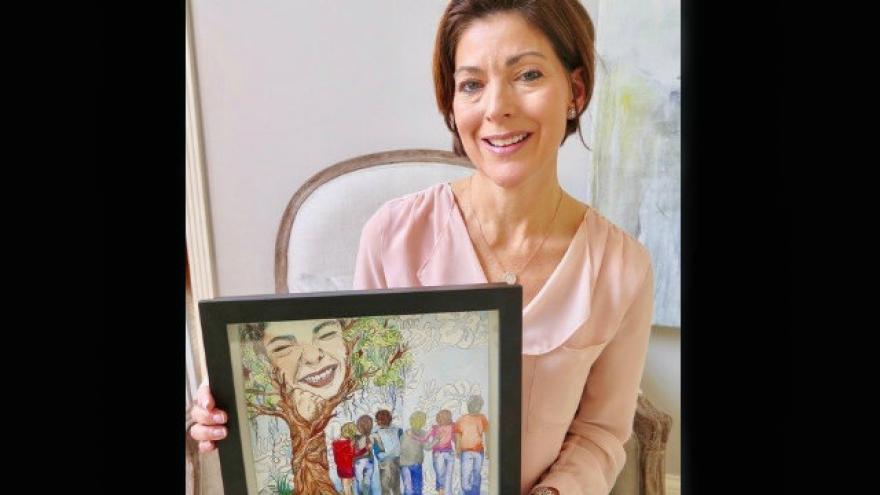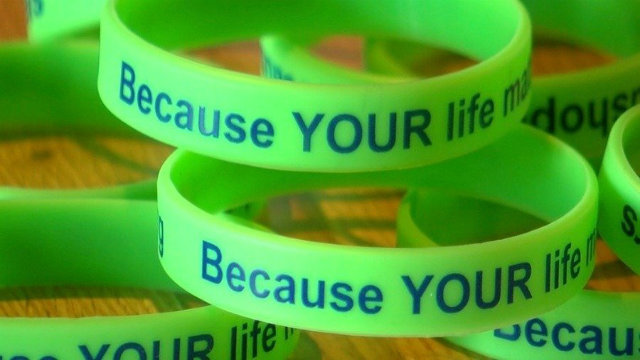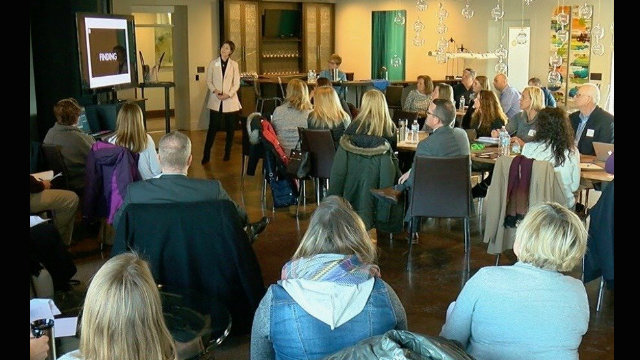Ohio teen's suicide inspires parents to save lives
 Diane and her husband Tom Egbers, have found hope after their son\'s suicide through helping others. They formed Grant Us Hope in 2016 with the goal of reducing teen suicide in the Tri-State. Photo courtesy WCPO
Diane and her husband Tom Egbers, have found hope after their son\'s suicide through helping others. They formed Grant Us Hope in 2016 with the goal of reducing teen suicide in the Tri-State. Photo courtesy WCPO
By Lucy May & Tanya O'Rourke
Cincinnati, Ohio (WCPO) -- Diane Egbers held her son Grant in her arms as he took his last breaths.
The 15-year-old St. Xavier High School sophomore died by suicide on Feb. 7, 2015, after several months of treatment for depression and recurring migraines. He went from being the most joyful boy in school to being completely devoid of hope.
"I was there when that sweet child came into this world, and I am forever blessed to have held him when he left this world," Diane Egbers said.
"Suicide shatters a family and all the friends around it," she said. "And you're on your knees picking up thousands of pieces a piece at a time, and the picture is never going to be the same. But you have to do it. You have to find hope."
She and Grant's father, Tom Egbers, have found their hope through helping others. They formed Grant Us Hope in 2016 with the goal of reducing teen suicide in the Tri-State. Now the nonprofit is bringing a peer-to-peer counseling program called Hope Squad to Greater Cincinnati in the fervent belief that it can save young people and their families from the pain the Egbers family has endured.
"When you go through something like that, you would do anything and everything in the world," Tom Egbers said. "If you could spend the rest of your life and save one person and save one family from having to go through this, it would be worth it."
Diane Egbers said she knows not every suicide can be prevented, but she believes far more could be.
"It is a preventable cause of death -- we know that," she said. "Car accidents aren't, but suicide is. And that's our opportunity. Our opportunity is to reach these kids sooner and get them the help they need."
Hope Squad accomplishes that through the people that students confide in most often: other students.
The Hope Squad program traces its beginnings back to 1998. That's the year that police asked Greg Hudnall, who was then a high school principal, to identify the body of a 14-year-old who had killed himself in the public park next to his school.
"I actually had to move the body to identify him. And afterwards I walked to my car, and I literally threw up and sobbed," he said. "I mean this was an amazing young man."
Hudnall vowed then to do anything he could to help prevent suicide in his Provo City School District of 14,000 students.
The district was averaging one or two suicides each year, including that of a fourth-grader who died on school grounds. Hudnall moved to the school district office before long and established the Circles4Hope community suicide prevention model.
"While it takes an entire village to raise a child, we believe it takes an entire community to save one," he said.
That model helped reduce suicides, but it wasn't until Hudnall launched the Hope Squad program that the school district saw the best results.
Hope Squads are made up of students nominated by teachers and administrators based on surveys of the student body. The surveys ask every student at a school to list the names of their fellow students they would trust if they were struggling emotionally and needed to talk with someone.
In the first Utah high school where a Hope Squad was tried, Hudnall and his team interviewed all 2,100 students. Out of all those students, the same 40 names rose to the top of the completed surveys, he said.
"So we pulled them together, started training them on how to recognize the signs, how to talk with friends," Hudnall said. "But most important, when to go to an adult. It was so successful, we put it in 13 elementaries, three middle schools and three high schools -- our entire district."
Provo City School District went for more than nine years without a single death by suicide.
And over the past two decades, the program has spread to 300 schools in Utah and also operates in 10 additional states and in Canada.
Jennifer Wright-Berryman is the lead researcher at the national level for Hope Squad and is an assistant professor of social work at the University of Cincinnati. She began focusing her research on adolescent suicide after the community where she lives in southern Indiana lost several teens to suicide in a short period of time.
"They were all close friends of my daughter," Wright-Berryman said. "My daughter looked at me and said, 'Mom, I don't want to lose any more friends.'"
Wright-Berryman learned about Hope Squad during her research and was so impressed with the program that she helped bring it to Bartholomew County where she lives.
She said there are three things that make Hope Squad so effective:
A "constant dosing" of intervention. "Hope Squads are always there," she said. "They don't come in and out. They aren't a one-shot deal." With 40 to 50 students that get extensive training in each school, they can help change the culture at their schools by educating their peers, teachers and staff, she said.
Evidence-based strategy. Students who are members of their schools' Hope Squads get training that has been well researched and proven to be effective, she said.
Not a passive program. Wright-Berryman said that's the most important thing for her as a parent of teens.
"These students are taught to go out and look, listen, feel, check, call, care," she said. "These students are out there asking, following up, asking their peers 'how are you today? I hear that you and your boyfriend broke up. Can I sit with you at lunch?' These intentional outreaches set Hope Squad apart."
That might sound like a lot of pressure for the students that become Hope Squad members.
Hudnall said it's important to understand that most of those students already have been hearing from friends who are struggling. They just haven't known the right thing to say or how to help. Hope Squad provides the training that allows them to get their friends the help they need.
For adults who worry that the Hope Squad members might get bullied because of their efforts, Wright-Berryman acknowledged that happens occasionally. However, the Hope Squad students have protection, she said.
"We do bullying training," she said. "Also, they have each other. So when you're talking about eight to 10 per grade per school, and you're talking about 40 to 50 kids, you've got kids who can talk to each other, lean on each other, protect each other. And I think that's really powerful."
Already, more than 20 schools in Greater Cincinnati are working with Grant Us Hope to pilot the program with a goal of having Hope Squads in place within 18 months, encompassing at least 30,000 students in the region.
"We anticipate this will grow and grow," Diane Egbers said.
As the sponsoring organization for Hope Squad in Ohio, Grant Us Hope has a goal of getting the program into every Ohio school where the community deems it a good fit, she said. Grant Us Hope is working to bring the program to some Northern Kentucky school districts, too, Diane Egbers said, so that Greater Cincinnati as a whole can benefit from Hope Squad's powerful approach.
Mason City Schools, which had a high school student die by suicide earlier this year and another high school student die by suicide last year, is one of the school districts that has agreed to pilot the Hope Squad program locally.
Mason Superintendent Gail Kist-Kline said the school district hopes to launch training in its high school this year in order to have its first Hope Squad in place next school year.
"It's giving students the permission to have those conversations and the skills as to what do I do next. That's the magic of this program," she said.
Based on the experience that other schools have had, the impact should reach beyond suicide prevention to "shaping a culture where kids feel like they can talk to one another, report things and having someone they can confide in and trust," she said.
Trenton Borders, a senior at Mason High School, said students are eager for the new program to start. Borders, 18, had been critical of the Mason City Schools administration for what he considered a lack of action to address the problem of suicide. He said he's "very satisfied" with the Hope Squad approach.
"It's peer-led, which is something I really like," he said. "I feel like it could be more successful."
Borders said he knows that people don't like to talk about suicide, but it impacts students whether the adults around them talk about it or not.
"It made a lot of people very upset, especially students who already struggle with mental illness," he said. "I definitely think it can encroach on the mental health of the students."
Diane Egbers knows all too well how frightening the subject of suicide can be for parents -- so frightening, in fact, that many don't discuss it.
"The reason we don't talk about it is, we as parents can't control it. We can't see it. We can't define it. We can't understand it really," she said. "I still don't understand what Grant really went through. All I know is the outcome. I know how he described it, but I don't understand. I've not been mentally ill. I don't understand it. So we're terrified as parents about what we fear and what we don't understand."
Even so, parents care deeply about their children's mental health and are desperate for ways to help their kids, said Jim Mason, the president and CEO of Beech Acres Parenting Center.
Beech Acres did research last year with groups of Greater Cincinnati parents to figure out what their biggest concerns were.
The second most important thing those parents identified as a concern was understanding their children's mental health, he said. The only concern ahead of that was understanding their kids' emotional development, which is closely related.
"What this tells us is this is on parents' minds," Mason said.
Beech Acres has been working with a small group of local schools to help parents identify their children's natural gifts, whether that's being compassionate or kind or loving or grateful. The goal is to help parents focusing on developing those strengths, thereby helping their children to be more resilient as they grow.
He sees the program as a tool that Hope Squads could use to help change a school's culture.
"It's talking about what you're good at," he said. "Now they're having conversations about what their gifts are instead of what their fears are."
For parents who already have children who are experiencing the loneliness, self-doubt and isolation that can spiral into bigger problems, it's important for them to stay engaged in their kids' lives and encourage them to spend more time doing what they enjoy.
"The biggest problem is that sense of isolation, that nobody gets me," Mason said. "A parent who is right there with their child, it shows that child, 'I love you, and I will always be there to support you.'"
Tragically, that doesn't work every time.
As soon as Diane and Tom Egbers found out their son was depressed, they sought the best treatment they could. Grant went to therapy and was on medication designed to help him.
But they didn't find out until early October of 2014, Diane Egbers said. Part of the goal of Hope Squad is to find out early and get students the treatment they need.
Grant's parents didn't have enough time to find the right level of treatment to help him.
"We kept going back to the doctors, and they would say, 'this takes four to six months.' And with our son, we didn't have four to six months," Diane Egbers said.
If there had been a Hope Squad at St. Xavier High School when Grant was a student there, she is convinced her son would have benefited and would still be alive today.
"If Hope Squad had been in Grant's school, first off, when he was healthy, he would have loved to be a Hope Squad member. That was so his heart," she said. "When I look at every Hope Squad, I'll see that unconditional love of my son. Hope Squad is a representation of that for me, but it's also just knowing that kids who are great kids who are suffering with mental illness will get help."
And that's the thing. Before Grant hit puberty and started battling depression, he was the happiest, most grateful child imaginable, his dad said. At Grant's funeral, a dozen different students approached his parents and told them Grant was their best friend, and he made every single one of them feel like his best friend, too, Tom Egbers said.
That makes it all the more difficult for people to understand how a child with such zest for life could become a teen who can't bear the pain of life any longer, he said.
"I don't believe that Grant took his life," he said. "I believe that this disease stole his life from him."
If there had been a Hope Squad to learn about Grant's pain earlier, Diane Egbers said, she believes she could have found out about Grant's struggle six or nine months sooner.
"I think that the medications that didn't work, we would have figured that out," she said. "And we likely would have gotten him onto something that would have worked."
It's a part of Grant's story that his parents cannot rewrite. So instead, they're doing all they can to make sure other families and other struggling teenagers get a different ending.
"Even though we're afraid, we have to let the kids lead," Diane Egbers said.
It's about working peer-to-peer and getting the students who are struggling to an adult that can help, she said, "because that's the answer."
The-CNN-Wire
™ & © 2018 Cable News Network, Inc., a Time Warner Company. All rights reserved.


